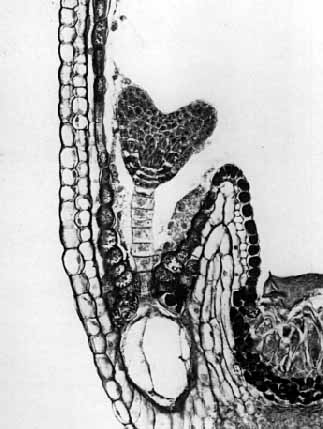
Primary goals of plant developmental and structural studies are to elucidate structural and developmental principles and mechanisms, from the level of the gene to the cell to the whole organism, and to understand the relationship of plant form and environment within each organism's phylogenetic history. The top three priority areas identified by respondents to a survey from the BSA were: molecular genetic control of development; relationships among structure, function, and development; and relationships among evolution, development, and systematics.
Undergraduate education is an area of critical need. Low student interest and scarcity of majors plague undergraduate programs. Revitalizing classroom studies in structure could be achieved by using video microscopes on living plant material and by time-lapse
 |
|---|
| The heart-shaped (emergence of cotyledons, the first leaves) stage in the development of an embryo of shepherd's purse (Capsella bursa-pastoris). Courtesy: Ray F. Evert. |
Graduate student funding is also critical. Sufficient funding is required for assistantships, supplies, travel, new faculty positions, and new equipment. Many of these funds come through operating grants for research. Faculty guidance should provide leadership in critical thinking, writing proposals, attending meetings, and experience in teaching for those who plan to remain in academia; students should receive broad training with a focus on competitive research areas. Successfully competing for the best students is critical to the health and future of developmental and structural botany, as is attracting and retaining students and faculty in underrepresented groups, such as African Americans, Native Americans, Hispanics, and women.
Funding sources for research in development and structure are scarce. Despite an apparent wealth of funding sources, many support only one or two plant scientists in a given program. Structural plant research is currently unrepresented at any national science agency. This indicates that structural studies have been outside the disciplines of biology defined by funding agencies. Incomplete review of structural research proposals by these agencies places structural pursuits in peril by their lack of adequate representation. A danger of irreparable harm may exist for "unfashionable" areas that are fundamental to botanical pursuits at large; important areas should be given adequate personnel and financial resources to sustain them. Since many unfunded proposals are rated nearly as highly as funded ones, competitive programs may be eliminated by too restrictive rates of research awards.
Funding, even at reduced levels, is required to retain competitive researchers and maintain national capabilities in all areas of plant biology. Increased opportunities should be provided by Congress for improved individual research through increased funding, redistribution of funds from larger programs, or distribution of funds to more researchers-even if some awards must be reduced and indirect costs capped to provide sufficient funding. Institutional reorganization and development should be "bottom up and not "top down," with job areas determined locally, job advertisements broadly worded, and positions fully supported in space, equipment, start-up funds, and released time. A flexible division of labor and interests is desirable so that excellence in every area receives recognition.




